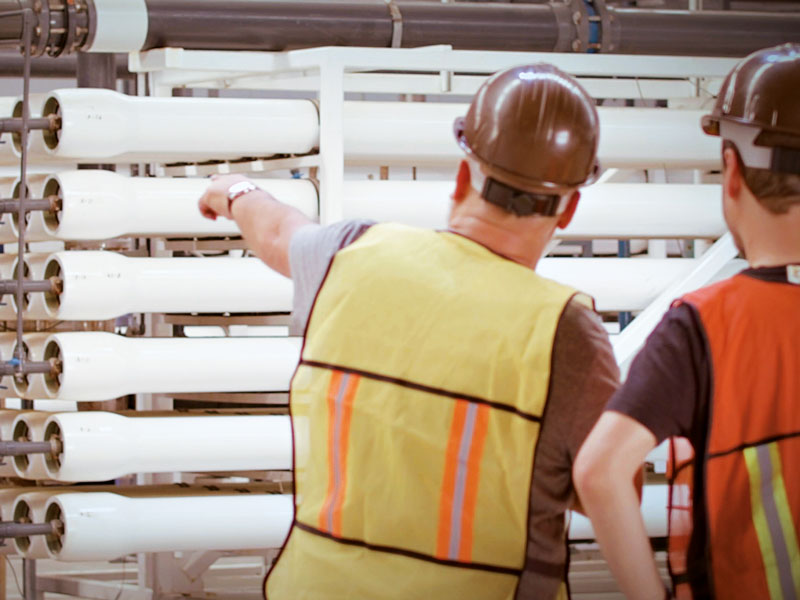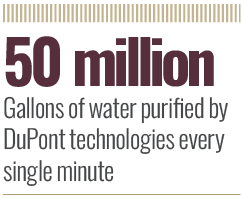
Top 5
Water and sustainability have always been inextricably linked. As our planet warms, we feel the impact of climate change through changes in water. Climate change is increasing the frequency and severity of droughts, flooding, sea level rise and other phenomena, putting the quantity and quality of our freshwater resources at risk. That is why the role of the water sector is more important than ever – innovating numerous ways to optimise this precious resource to meet our domestic, industrial and agricultural needs.
Today, DuPont Water Solutions technologies purify more than 50 million gallons of water every minute in 112 countries. While some of these water purification approaches have been trusted and used for decades, our most recent advancements are unlocking previously untapped water sources and enabling our customers to reliably treat challenging waters – including wastewater – for reuse.
Reducing the costs
With water resiliency solutions more vital than ever, water treatment innovators are in line with the overarching water sector objective – to reduce the total cost of water. This goes beyond lowering operational costs but also includes reducing the environmental footprint. While the sector embraces this need, it has often been hard to compare solutions or make the business case for modernisation for sustainability. As such, in 2024 our team introduced the Water Solutions Sustainability Navigator, a digital tool that enables users to compare how different potential water treatment solutions impact sustainability indicators, including carbon emissions, chemical usage, wastewater produced, solid waste generated, and spatial footprint – with calculations third-party verified to be in conformance with relevant ISO standards.
Our most recent advancements are unlocking previously untapped water sources
The tool compares various water treatment technologies, whether from DuPont or from other manufacturers. Currently, the tool allows users to input four different water treatment technologies – reverse osmosis, ultrafiltration, ion exchange resins, and membrane bioreactors – used alone or in combination. With many factors influencing the design and selection of water treatment solutions, the tool helps users better understand the interconnection of sustainability-driven choices and the cost of operations.
By uncovering solutions that require fewer chemicals, less energy or a smaller spatial footprint, our customers are not only reducing their impact on the planet, but also driving down the total cost of water. In one example of the tool’s use, the United Arab Emirates’ (UAE) energy strategy includes a commitment to Net Zero by 2050. This region relies on energy-intensive seawater desalination to supply freshwater and was seeking a lower carbon footprint desalination process.
A planned 320MM litre per day UAE desalination system was studied using the navigator tool, and the use of FilmTec Seamaxx RO element was estimated to provide the lowest carbon impact and energy use over its estimated five-year operating life compared to other elements in its class. In a system this size, the potential carbon impact savings over the next best element alternative were estimated at 46,000 MT CO2e.
In another example, the Sustainability Navigator was used to measure the CO2 emission savings generated by advancing the performance of reverse osmosis membranes as compared to predecessor technology.
Advancing performance
Using the World Business Council for Sustainable Development (WBCSD) Avoided Emissions Guidance, a recent case study showcases how DuPont’s commitment to advance the performance of its membranes, such as FilmTec BW30 PRO-400 reverse osmosis elements, supports the reduction of carbon emissions among their global customers.

Advanced FilmTec BW30 PRO-400 RO elements, introduced to the market in 2022, transform brackish water sources into high-quality freshwater to secure water access for industrial, energy, or municipal users while using lower operating pressures, as compared to the previous versions.
As such, these advanced membranes require three percent less energy to operate – leading to reduced carbon emissions (180 MT CO2e for a mid-sized facility over a five-year operating lifetime of the element) and costs for users.
As achieving water resiliency continues to rise in priority around the globe, DuPont’s water treatment innovations are ready to be put to work and help make more freshwater available regardless of the local water challenges.
Moreover, choosing technologies best suited to lower the cost of operations and reduce the environmental footprint is made easier through the use of the Water Solutions Sustainability Navigator. We are especially proud to be named by World Finance as the most sustainable in the water sector – increasing the sustainability of our sector will enable a more secure water future for humans in every part of the world.


